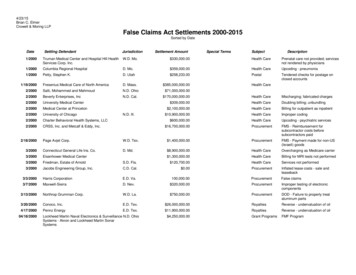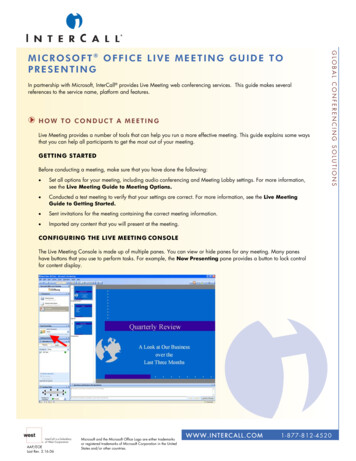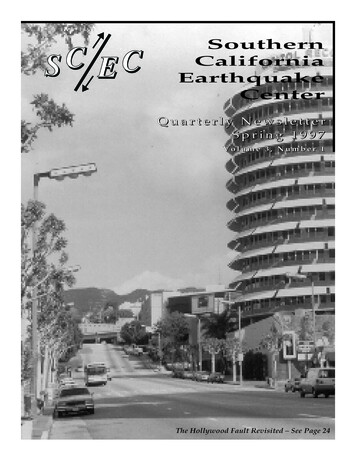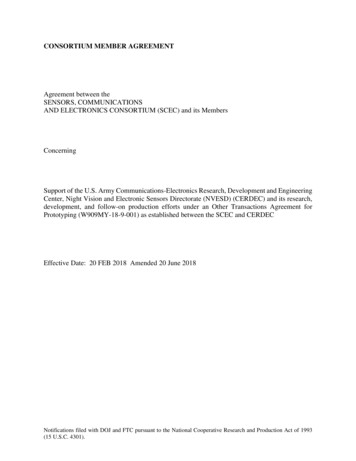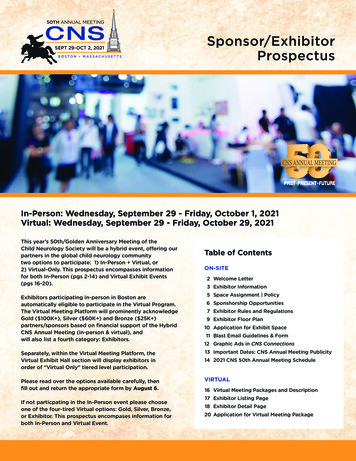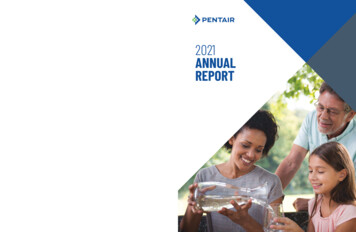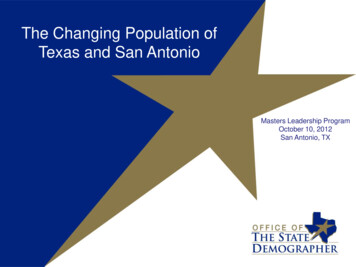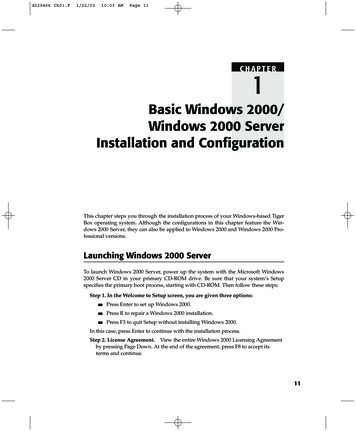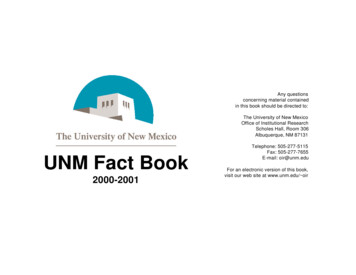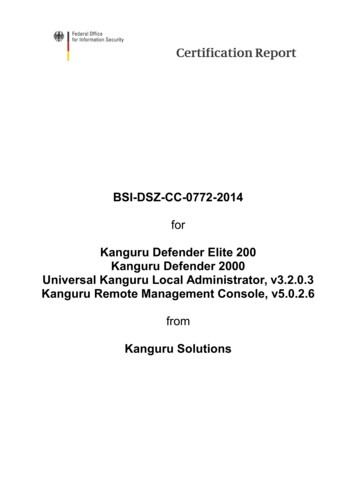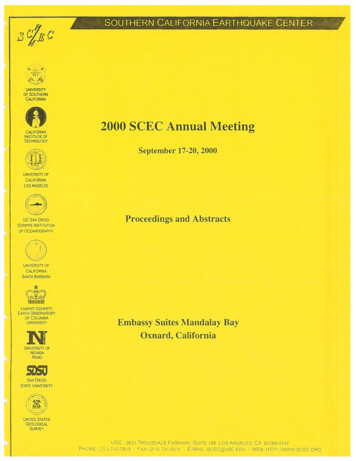
Transcription
SOUTHERN CALIFORNIA EARTHQUAKE CENTERUNIVERSrrOF SOUTHERNCALIFORNIA0CALIFORNIAINSTITUTE OFTECHNOLOGY2000 SCEC Annual MeetingSeptember 17-20, 2000(‘UNIVERSITY OFCALIFORNIALOS ANGELES6UC SAN DIEGOSCRIPPS INSTITUTIONOF OCEANOGRAPHYProceedings and AbstractsUNIVERSITY OFCALIFORNIASANTA BARBARALAMONT-DOHERTYEARTH OBSERVATORYOF COLUMBIAUNIVERSITYNEmbassy Suites Mandalay BayOxnard, CaliforniaUNIVERSITY OFNEVADARENOSAN DIEGOSTATE UNIVERSITYUNITED STATESGEOLOGICALSURVEYUSC 3651 TROUSDALE PARKWAY, SUITE 966. LOS ANGELES, CA 9(Y89-O742PHONE. (213) ‘4-5343FAX: (213) 7-S-UU11E-MAIL: SCECUSCEDUWEB. HTTP:WWWSCEC.QRG---
2000 SCEC Annual MeetingSeptember 17-20, 2000Proceedings and AbstractsEmbassy Suites Mandalay BayOxnard, California1
Table of ContentsSCEC Annual Meeting Agenda32000 Annual Meeting Participants6SCEC Organization102000 SCEC Advisory Council12SCEC Senior Research Investigators13Message from the Directors17The Current Status of EarthS cope18SCEC Outreach Program Overview202000 SCEC Abstracts39
2000 SCEC ANNUAL MEETING“The SCEC Transition and Future”Sunday, September 17Arrival in Oxnard2:00 to 5:00Santa Clara Basin Working Group MeetingSteve Day-There may be other specialized group meetings this afternoon.Poster Session Set-Up7:00SCEC Steering Committee MeetingMonday, September 18, 20006:00 to 8:30Breakfast (Surf Room)SCEC Plenary Session I8:30Introduction8:45EarthScope Update9:00NSF Perspective9:15USGS Perspective9:30SCEC Advisory Council Perspective9:45Education and Outreach Report Jill AndrewsIntern Introduction10:20Break10:45SCEC Science Report Highlighting the First Decade—John McRaney——Tom HenyeyJim Whitcomb—John Unger—Bob Smith--—Bernard MinsterThe SCEC Highlights (15 minutes each)11:1511:3011:4512:00Southern California as a Natural Laboratory Bernard MinsterThe Landers Story Duncan Agnew/Tom RockwellThe L.A. Basin Story (including the Northridge EQ)— Ralph ArchuletaData Collection, Synthesis, and Products Ken Hudnut12:15—1:30Lunch———3
1:301:452:002:152:30Hazard Estimation Dave JacksonFault System Behavior Steve DayEducation and Outreach Jill AndrewsNew Master Model Ned FieldSCEC Themes Tom Henyey2:45Discussion of SCEC Highlights3:15Instructions to Working Groups on 2001/Year 11 Plans— Bernard Minster——————What is Missing?Group Meetings (Note: There will be some overlap in the group meetings)3:30SCIGN Coordinating Board Meeting3:30-5:00Group A4:30-6:00Group B5:00Cocktail Hour and Dinner—7:00———Ken HudnutDave JacksonRalph ArchuletaSCEC Advisory Council Executive Session (begins during dinner)7:00Poster Session ITuesday, September 19, 20007:30—8:30Continental Breakfast8:00-9:30Group C9:00-10:30Group D10:00-11:30Group E11:00-12:30Group F— Steve Day12:30Lunch———Tom RockwellRob ClaytonDuncan AgnewSCEC Plenary Session II2:002:30Introduction to SCEC 2 and Breakout Session— Tom Jordan—5:30Breakouts (Chairs/Co-Chairs to be named later)First Session2:30—4:00Rupture DynamicsMicroscale ProcessesFault Systems———4
Second Session4:005:30—Plate-Boundary TectonicsWave PropagationSeismic Hazard Analysis-——5:307:00—Cocktail Hour and DinnerOutreach Awards7:00Poster Session II8:30SCEC Advisory Council MeetingWInSAR Meeting David SandwelllChair-Wednesday, September 20, 2000SCEC Plenary Session Ill7:308:30——8:30Continental Breakfast10:00Reports from Breakout GroupsBreak10:0010:30—11:30Discussion of Breakouts and Vision for SCEC 2 Jordan-End of SCEC Meeting1:00SCIGN Advisory Council Meeting5
2000 SCEC ANNUAL MEETING PARTICIPANTSRobert AbbottDuncan AgnewOrgil AltangerelMarie AmmermanGreg AndersonJohn AndersonJill AndrewsRasool AnooshehpoorRalph ArchuletaRamon ArrowsmithAris AspiotesKenneth AustinShirley BaherTeresa BakerMark BenthienYehuda Ben-ZionMichael BevisJacobo BielakTom BjorklundJay BlaireAnn BlytheYehuda BockMargaret BoettcherFabian BonillaAdrian BorsaRich BriggsEITIi1y BrodskyJim BruneDoug BurbankRoland BurgmannTianqing CaoJi ChenLiangjun ChenPo ChenYoulin ChenYun-tai ChenShari ChristoffersonRob ClaytonLaura ColiniMichele CookeC.B. CrousePaul DavisSteve DayDesiree DierBob de GrootSafaa DerghamJim DietenchJames DolanAndrea DonnellanHerb DragertDoug DreorerDeborah asonNevada-RenoUC-San DiegoSan Diego StateSCEC InternfUC-Santa BarbaraUC-San DiegoNevada-RenoSCEC OutreachNevada-RenoUC-Santa BarbaraArizona StateUSGS-PasadenaCentral WashingtonUCLASCEC Intern/MITSCEC n DiegoMITUC-Santa BarbaraUC-San DiegoNevada-RenoCaltechNevada-RenoPenn techArizona StateMassachusettsURS CorpUC-Los AncelesSan Diego ‘tateSan Diego StateSCEC OutreachCSU-Long BeachUSGS-Menlo ParkUSCJPLGeological Survey of CanadaUC-BerkeleyCaltech6
Leo EisnerAntonio FernandezNed FieldSheryl FontaineBill FoxallJeff FreymuellerGary FuisJohn GaletzkaCarrie GlavichJavier GonzalezLisa GrantRobert GravesLarry GurrolaKatrin HafnerBrad HagerRobert HamiltonJeanne HardebeckRuth HarrisRoss HartlebEgill HaukssonTom HeatonSally HenyeyTom HenyeySue HoughYue-qiang HuangKen fludnutKen HurstDave JacksonAllison JacobsLucy JonesAlexandra JordanTom JordanYan KaganMarc KamerlingNancy KingRobert KingMonica Koi1erJohn LabrecqueDaniel LavalleeMark LeggShoshana LevinYong-Gang LiEric LibickiScott LindvallPeng-Cheng LiuYun-Feng LiuJohn LouieBruce LuyendykHarold MagistraleNarbik ManukianJohn MarquisAaron MartinKevin MassSally -RenoLLNLAlaskaUSGS-Menlo ParkSCIGN/USCUC-Santa BarbaraCICESEUC-IrvineURSUC-Santa BarbaraCaltechMITNational Academy of SciencesUC-San DiegoUSGS-Menlo sadenaJPLUC-Los AngelesSCEC InternfUC-San DiegoUSGS-PasadenaSCEC Intern/USCUSCUC-Los AngelesUC-Santa BarbaraUSGS-PasadenaMITUC-Los AngelesNASAUC-Santa BarbaraLqgg GeophysicalUSCUSCUSCWilliam Lettis Assoc.UC-Santa BarbaraUSCNevada-RenoUC-Santa BarbaraSan Diego StateUSCSCEC OutreachUC-Santa BarbaraSCEC Intern/WhittierCal State-San Bernardino7
John McRaneyBernard MinsterLalliana MualchinJanice MurphyNancy NatekLaura Nett-CarringtonCraig NicholsonDavid OcxlesbyDavid OhyaKim OlsenJohn OrcuttMike OskinSue OwenTracy PattelenaZhi-Gang PengSue PerryAndreas PleschWill PrescottEvelyn PriceKenton PrindleDaniel RagonaDaniel RaymondMike ReichieJim RiceTom RockwellYufong RongPaul RosenbloomCharlie SammisDave SandwellJim SavageMichael ScharberJon SchullerNano SeeberPaul SegallGordon SeitzAmy SeltingEnnco SerpelloniBruce ShawKaye ShedlockZheng-Kang ShenGerry SimilaMark SimonsBob SmithMichelle SmithStewart SmithChris SorlienKeith StarkJamie SteidiRoss SteinClay StevensToshiro TanimotoJerry TreimanSusan TubbesingJohn UngerSCECUC-San DiegoCaltransUSGS/Menlo ParkSCEC Intern/New MexicoUC-San DiegoUC-Santa BarbaraUC-RiversideUSCUC-Santa BarbaraUC-San DiegoCaltechUSCSCEC InternlUC-Santa CruzUSCECIHarvardUSGS-Menlo ParkUC-BerkeleyUC-Santa BarbaraSan Diego StateSCEC InternfUC-IrvineCDMGHarvardSan Diego StateUCLAUSCUSCUC-San DiegoUSGS-Menlo ParkUC-San DiegoUC-Santa BarbaraLamontStanfordLLNLUC-Santa BarbaraUCLALamontUSGS/GoldenUCLACal tUSGS-PasadenaUC-Santa BarbaraUSGS/Menlo ParkSCEC IntemlCal State-NorthridgeUC-Santa BarbaraCDMGEERIUSGS-Reston8
Mall van DomselaarKathryn van RoosendaalShannon VanWykJan VermilyeJohn VidaleAntonio Vidal-VilegasDave WaldSteve WardKns WeaverFrank WebbJoel WedbergShelly WernerSteve WesnouskyRob WessonJim WhitcombFrank WyattZhimei YanBob YeatsBill YoungJeri YoungDoug YuleHowar ZebkerYuehua ZengLi ZhaoLupei ZhuUCSDSCEC IntemlCal sadenaUC-Santa CruzLettis and n DiegoCaltechOregon StateSCIGNArizona StateCSU-NorthridgeStanfordNevada-RenoUSCUSC9
SCEC ORGANIZATION 2000-ManagementCenter Director:Thomas L. HenyeyUniversity of Southern CaliforniaScience Director:J. Bernard MinsterUniversity of California, San DiegoDirector for Administration:John K. McRaneyUniversity of Southern CaliforniaDirector for OutreachJill H. AndrewsUniversity of Southern CaliforniaBoard of DirectorsChair:J. Bernard MinsterUniversity of California, San DiegoVice-Chair:Ralph ArchuletaUniversity of California, Santa BarbaraMembers:John AndersonUniversity of Nevada, RenoRobert ClaytonCalifornia Institute of TechnologyThomas H. JordanUniversity of Southern CaliforniaKenneth Hudnut*United States Geological SurveyDavid D. JacksonUniversity of California, Los AngelesThomas RockwellSan Diego State UniversityLeonardo SeeberColumbia UniversityEx-officio: Thomas HenyeyUniversity of Southern Californiarepresents Lucy Jones on Board.10
Research Group LeadersA: Master Model:David D. JacksonUniversity of California, Los AngelesB: Strong Motion Prediction:Ralph ArchuletaUniversity of California, Santa BarbaraC: Earthquake Geology:Thomas RockwellSan Diego State UniversityDIP: Subsurface Imagingand Tectonics andSeismicity andSource Parameters:Robert ClaytonCalifornia Institute of TechnologyE: Crustal Deformation:Duncan AgnewUniversity of California, San DiegoG: Earthquake SourcePhysics:Steve DaySan Diego State UniversitySteering Committee Members (ex-officio)Director EmeritusKeiiti AkiUniversity of Southern CaliforniaState of California RepresentativeJames DavisCalifornia State GeologistSCIGN Board ChairmanKen HudnutUnited States Geological Survey11
2000 SCEC ADVISORY COUNCILRobert SMITH (Chair), University of Utah, Department of Geology and Geophysics, Salt Lake City,UT 84112-1183Lloyd S. CLUFF, Pacific Gas and Electric Co., Geosciences Department, P.O. Box 770000, MailCode N4C, San Francisco, CA 94177C. B. CROUSE, URS Corporation, 2025 First Avenue, Suite 500, Seattle, WA 98121George DAVIS, Department of Geosciences, University of Arizona, Tucson, AZ 85721James DIETERICH, United States Geological Survey, 345 Middlefield Road, MS 977,Menlo Park, CA 94025Robert HAMILTON, NRC/National Academy of Sciences, 2101 Constitution Ave., NW,Washington, DC 20418Dennis MILETI, University of Colorado, Natural Hazards Research and Applications InformationCenter, Campus Box 482, Boulder, CO 80309-0482Jack MOEHLE, Pacific Earthquake Engineering Center, University of California, 1301 South 46thStreet, Richmond, CA 94804-4698Barbara ROMANOWICZ, University of California, Berkeley, Department of Geology andGeophysics, Berkeley, CA 94720Kaye SHEDLOCK, United States Geological Survey, Denver Federal Center, MS 966, Denver, CO80225Susan TUBBESING, EERI, 499 14th St., Suite 320, Oakland, CA 94612-1902Mary Lou ZOBACK, United States Geological Survey, 345 Middlefield Road, MS 977,Menlo Park, CA 9402512
Southern California Earthquake CenterSenior Research Investigators (2000)Center Director:Thomas L. HenyeyDepartment of Earth SciencesUniversity of Southern CaliforniaLos Angeles, California 90089Science Director:J. Bernard MinsterScripps Institution of OceanographyUniversity of CaliforniaSan Diego, California 92093Principal InstitutionsScientistsUniversity of Southern CaliforniaDepartment of Earth SciencesLos Angeles, California 90089Yehuda Ben-ZionJames F. DolanYong-Gang LiDavid OkayaSusan OwenCharles G. SanmiisLeon TengLupei ZhuCalifornia Institute of TechnologySeismological LaboratoryPasadena, California 91125Robert ClaytonMichael GurnisEgill HaukssonThomas HeatonDonald HelmbergerMartha HouseHiroo KanamoriKerry SiehMark SimonsJoann StockColumbia UniversityLamont-Doherty Earth ObservatoryPalisades, New York 10964John ArmbrusterLeonardo SeeberBruce ShawLynn SykesUniversity of CaliforniaDepartment of Earth and Space SciencesLos Angeles, California 90024Paul DavisYan KaganMonica KohierZheng-kang ShenJohn VidaleUniversity of CaliforniaScripps Institution of OceanographyLaJolla, California 92093Duncan AgnewYehuda BockDavid SandwellPeter ShearerFrank VernonNadya WilliamsFrank Wyatt13
University of CaliforniaDepartment of Geological SciencesSanta Barbara, California 93106Ralph ArchuletaMarc KamerlingEdward KellerDaniel LavalleePeng-Cheng LiuBruce LuyendykCraig NicholsonKim OlsenChris SorlienJamie SteidiUniversity of NevadaDepartment of Geological SciencesReno, Nevada 89557John AndersonRasool AnooshepoorJames BruneJohn LouieRaj SiddharthanFeng SuSteven WesnouskyYue-hua ZengSan Diego State UniversityDepartment of Geological SciencesSan Diego, California 92182Steven DayHarold MagistraleThomas RockwellUnited States Geological SurveyEdward FieldGary FuisTom HanksRuth HarrisSusan HoughKen HudnutPeggy JohnsonLucy JonesNancy KingDaniel PontiRoss SteinDavid WaldLisa WaldMember InstitutionsScientistsArizona State UniversityTempe, ArizonaRamon ArrowsmithUniversity of CaliforniaBerkeley, CaliforniaRoland BurgmannEvelyn PriceUniversity of CaliforniaDavis, CaliforniaLouise KelloggUniversity of CaliforniaIrvine, CaliforniaLisa Grant14
Steven WardUniversity of CaliforniaEarth Sciences Board of StudiesSanta Cruz, California 95064California Division of Mines and GeologyJames DavisMichael ReichieCalifornia State UniversityNorthridge, CaliforniaGerry SimilaDoug YuleCalifornia State UniversityDepartment of GeologySan Bernardino, California 92407Sally McGillCarnegie Mellon UniversityPittsburgh, PennsylvaniaJacobo BielakCentral Washington UniversityDepartment of GeologyEllensburg, Washington 98926Charles RubinUniversity of ColoradoDepartment of Geological SciencesBoulder, CO 80309Karl MuellerJohn RundleHarvard UniversityDepartment of Earth and Planetary SciencesCambridge, Massachusetts 02138James RiceJohn ShawJet Propulsion LaboratoryPasadena, CaliforniaDanan DongAndrea DonnellanMike HeflinKen HurstMichael WatkinsFrank WebbLawrence Livermore National LabLivermore, Cal iforni aBill FoxallGordon SeitzUniversity of MassachusettsMichelle CookeMassachusetts Institute of TechnologyDepartment of Earth, Atmospheric, andPlanetary SciencesCambridge, Massachusetts 02139Brad HagerTom HerringRobert KingSimon McCluskyRobert ReilingerUniversity of New MexicoAlbuquerque, New MexicoMousumi RoyUniversity of OregonDepartment of Geological SciencesEugene, Oregon 97403Gene HumphreysRay Weldon15
Oregon State UniversityDepartment of GeosciencesCorvallis, Oregon 97331Robert YeatsWhittier CollegeWhittier, CaliforniaJan VermilyeIndustry ParticipantsScientistsEarth Consultants InternationalOrange, CaliforniaEldon GathChris WallsMaxwell LabsLa Jolla, CaliforniaJeffry StevensWilliam Lettis and AssociatesWalnut CreekScott LindvallPacific EngineeringWalt SilvaPacific Gas and ElectricSan Francisco, CaliforniaNorman AbrahamsonWoodward-Clyde AssociatesPasadena, CaliforniaRobert GravesArben PitarkaChandon SaikiaPaul Somerville16
Message from the DirectorsTo:SCEC Group Leaders and the SCEC CommunityFrom: Bernard Minster and Tom HenyeyDate:August 28, 2000As all of you know, the upcoming annual meeting will be making plans for the current Center’sfinal (11th) year. Our budget for that year will be significantly less (15-20%) than for the currentone. In addition, we will begin planning for the renewal of SCEC at the annual meeting as youwill see on the agenda that John McRaney will be circulating. While there is considerableinterest at both the scientific and agency levels in seeing the center continue, it is by no means acertainty. For that reason, we feel that it is necessary to devote a portion of our 11th yearfunding to what might be termed “transitional science” scientific activities carrying us towardthe next generation of SCEC. This will further impact the dwindling budget.—For these reasons, we have decided that we will not engage in the usual proposal process for thisfinal year. Also, as you recall, we asked last year that proposals address the needs of SCEC’s“legacy”, but got very little return. Most proposals simply reflected business as usual. Thus, forthe 11th year, decisions on funding priorities will be made by the SCEC Steering Committee andBoard of Directors. (This recommendation was made by the Board at their meeting of February,2000)However, these decisions will not be made without input from the SCEC scientific community.While the annual meeting will be an important forum for gathering input, we urge the GroupLeaders to contact their group members, before the meeting if possible, to begin the dialogue ofhow to wrap things up. The annual meeting can then serve to summarize the input so that theGroup Leaders can present their plans to the full Steering Committee for discussion andcoordination. Groups will not be given budget targets, but instead should prioritize their fundingneeds, remembering that the budgets will be significantly reduced and that we must bringresearch activities to a logical conclusion even if the center is to continue.We also want to gather input on the future of SCEC and what activities we might beginthis transitional year. This part of the meeting will be led by Tom Jordan, who has been askedby the Board to lead the efforts to renew the center. He will work with the Steering Committeeon a transitional plan.17
The Current Status of EarthScopeEarthScope Working GroupAs most of you know, a Working Group consisting of representatives from the majorconsortia funded by the National Science Foundation has been assisting NSF in developing therationale for the proposed EarthScope facilities (USArray, SAFOD, PBO, and an InSARmission). Activities of this group (members are listed on the EarthScope Web site atwww.earthscope.org) have included organizing workshops to help define the major componentsof EarthScope, providing documentation and resource materials to NSF EAR staff as needed fortheir presentations to senior NSF management and the National Science Board, devising amanagement plan for implementation of EarthScope, and informing House and Senate membersand their staff about EarthScope and its value to the country.Status at NSFAs you no doubt are aware, EarthScope Phase I (USArray and SAFOD) has beenapproved by the National Science Board and was included in NSF’s FY01 request to Congress asan item in the Foundation’s MRE (Major Research Equipment) account. The Working Group isnow assisting NSF, NASA and USGS with Phase II (PBO) and Phase III (InSAR). Preliminaryindications are that these next phases have been well received by the agencies, and work hasbegun on developing them into EarthScope/MRE initiatives.Status in CongressDuring the initial FY01 Congressional budget negotiations earlier this year, the HouseAppropriations Subcommittee that deals with NSF was unable to support the full MRE requestthat included EarthScope “because of budget restrictions” and thus EarthScope was not includedin the initial budget report. The corresponding Senate Subcommittee and the full Committeehave yet to act. There is still the possibility that during the House-Senate conference, NSF’sbudget could be increased, including additional support for the MRE account and EarthScope.Contacts with your Congressional delegations can only help. But time is of the essence sincedecisions will be made later this month.MRE Phase I Facilities ProposalIn anticipation of the possibility that MRE funding for EarthScope may eventually beapproved for the FY01 budget, NSF has encouraged the EarthScope Working Group to submitan implementation proposal for the construction, operation, and maintenance of the facilitiesincluded in the Phase I MRE request. This would be for USArray and SAFOD as described inthe EarthScope planning document (see EarthScope Web site). The EarthScope Working Groupis assisting SAFOD and IRIS in the preparation of this proposal for submission on October 1.18
EarthScope Science SupportAssuming favorable action on the facilities funding, NSF intends to have a yearlycompetition to fund science proposals that utilize the EarthScope facilities. Science researchprojects related to EarthScope will be supported through the EAR Division at NSF, separatefrom the facilities. NSF is working on an announcement for this science support and expects tohave it issued by early next year. With the uncertainty in funding for FY01, it is likely that theinitial request for science proposals will focus on planning and exploratory grants, with requestsfor more specific proposals as the facilities develop over the next few years.Future PlanningJust a reminder that the next planning meeting for PBO will be October 30 to NovemberI in Palm Springs, California. Also to be scheduled is a briefing of Dan Goldin, Rita Colwell andChip Groat on InSAR by the Working Group Executive Committee in early October. Theevolution of EarthScope facilities and science plans will be an on-going process and your supportis both welcome and encouraged. The progress to date has been spectacular, and the supportfrom many areas has been encouraging. To continue on the road to success will require your ongoing involvement in planning workshops and your vocal and written support of the EarthScopeconcept in interactions with NSF, other federal agencies, Congress, and the public.19
The FY 2000 Southern California Earthquake Center (SCEC)Communication, Education and Outreach (CEO) Program:Overview, Method, Projects, Objectives, TasksBy Jill AndrewsIn collaboration with Mark Benthien, John Marquis, and Bob de GrootIntroductionSCEC, an interdisciplinary consortium of scientists and engineers who conductearthquake research using southern California as a natural laboratory, was established in1991 as a National Science Foundation (NSF) Science and Technology Center. Fromthe beginning, SCEC scientific activities were strongly influenced by a series of timely,moderate earthquakes in most cases damaging that occurred from 1987 19991.-——Center leaders recognized the urgent need to communicate the results of their researchwith the multiple millions of citizens who live and work in this seismically active region(and other populous regions affected by earthquakes), and established in 1992 the SCECCommunication, Education and Outreach (CEO) program. Today we represent over150 leading earthquake scientists from more than 30 academic institutions (a total of423 people make up today’s SCEC community of researchers, including principalinvestigators, post-doctorals, graduate and undergraduate students). We enjoy workingpartnerships with more than 50 other earthquake science, engineering, education, andgovernment organizations worldwide.CEO Mission and ProgramsWith ongoing expert advice from constituents and partners, SCEC leaders formed a CEOprogram mission that has evolved as Center activities matured: to increase earthquakeawareness and knowledge so that people take actions that improve safety andreduce loss.To fulfill this mission, SCEC leaders and CEO professionals emphasize the importanceof programmatic flexibility as new communications tools, technologies and methodsarise. We recognize that we must be responsive to change as research results emerge andunderstanding of earthquakes increases. Although we strive to maintain a cutting-edgeapproach, the basic program components remain constant: public awareness programsand products for media reporters and writers, civic groups and the general public;education programs and products for students, educators, and working professionals; andknowledge transfer programs and products for technical professionals, scientists andengineers. We manage an array of activities based on the Center’s scientific researchresults and processes. Products such as fact sheets, maps, posters, videos, working groupreports, news briefs, public awareness brochures, educational modules and curricula,11987 5.8 Whittier Narrows, 1992 6.1 Joshua Tree, 1992 7.3 Landers, 1992 6.2Big Bear, 1994 6.7Northridge, 1995 5.5 Ridgecrest, 1999 7.1 Hector Mine.‘2flI
proceedings, consensus documents and databases are disseminated through mechanismssuch as workshops, seminars, short courses, field trips, a web service, email listservices, print and electronic newsletters, museum exhibits, and media briefings andinterviews.PartnershipsWe recognized early on that partnerships could greatly enhance our efforts. Ourpartners are individuals and organizations who co-sponsor, support, or otherwiseaid in development and implementation of CEO activities and products. They areoften users of our products as well. (Figure 1, Page 3.) They have helped us bringtogether disparate groups (scientists engineers government officials educators thegeneral public) to attempt to solve the very complex problems posed by our active faults.(A distinction should be made here through our partnerships for knowledge transferwith agencies charged with producing official products that feature our scientific results,we conduct workshops that promote understanding and support of these items, such asofficial maps, databases, technical reports and documents.)—————Our partners in academia, government, industry and education aid us in assessment,evaluation and follow through by participating in our advisory groups and providingcost-sharing and matching funds. They also provide us with the ability to reach largeraudiences far beyond the borders of our study region. Since 1995, SCEC CEOprofessionals have been invited to conduct workshops and make presentations atearthquake science and engineering meetings throughout the United States as well asother countries such as Canada, Italy, New Zealand, China, Greece, and Japan.Earthquake researchers and CEO experts in many of these countries have based theirpublic awareness, education and knowledge transfer programs on the SCEC CEO model.We recently learned that Istanbul, Turkey, with an at-risk population of more than 11million, is creating an earthquake public awareness and education program that will bemodeled on the SCEC CEO program.I91
The FY 2000 Southern California Earthquake Center (SCEC)Communication, Education and Outreach (CEO) ProgramGOVERNMENTOFFICIALSBUILDING INDUSTRYPROFESSIONALSEMERGENCYPLANNERS& INSURERSTRANSFER\SCIENTISTS&ENGINEERSI CIVIC GROUPS-MEDIAREPORTERS& WRITERSURBAN\ PLANNERS\\\/ STUDENTS &EDUCATION & ��The SCEC CEO Mission isto increase earthquake awareness and knowledgeso that people take actions that improve safet and reduce loss.Figure 1.79I
CEO MethodEach SCEC CEO project is planned and executed in the context of our overall mission.Each has its own set of objectives and tasks related to products, disseminationmechanisms, and evaluation and/or follow-through mechanisms. The flow chart inbelow (Figure 2) illustrates the process, and the following pages describe current projects.ProductsLevellFact Sheets! Maps/VideosFAQs/lnterviewsReprints/Press ReleasesSCECScienceIWorking Group ReportsNewslettersRoots’ Updates(ResultsandProcesses)Dissemination MechanismsWorkshopsl SeminarsEvaluation? Follow ThroughMechanismsShort CoursesWeb Pages(Our activites as well asthose of our partners whichare based on ourproducts)Education ModulesPartnershipsWorkshopsMailings! E.rnail listslShort CoursesExhibitsSurveysLevel 2Curriculum DevelopmentConsensus DocumentsSpeakers BureauAnnual ReportsPress ConferencesProceedingsinternshipsMaps! DatabasesField TripsSocialSclenceStudlesPolicies EnactedPhase“Glossy’ BrochuresFigure 2.Partnerships
Project#100SCEC LegacyObjective(s)The legacy objective is to tellthe stories of SCEC’sscientific and CEO activitiesconducted during the firstdecade, with the goal ofsecuring future support froma variety of sponsors.Description I TasksThe first workshop to plan the SCEC LegacyDocument was conducted in July 2000 by members ofSCEC’s Steering Committee and Advisory Council.The group agreed that the most urgent next step is towrite a polished, full-blown proposal, with figures,that can be circulated and discussed at the SCECannual meeting.Stories to be told: LandersA session at the SCEC annual meeting will feature aseries of 10-15 minute talks that will serve as the basisfor the NSF proposal, which is due December 1, 2000. LA Basin Hypothesis testingData collectionFault system behaviorSCEC as a natural labMaster ModelGeneral Topics Integration / communitybuilding Open data / dataarchiving Model-basedinference/system-levelscience E&O Rapid, coordinatedresponse / cyberquakes Problem identification /consensus building Sustained scientificCEO’s participation will include short vignettes onhow SCEC has turned its science into productsacross all topics addressed in the proposal andsuggestions as to how it will continue with thoseeffective efforts. (Andrews to check list, makepresentation based on these stories).——Each presenter will write a narrative / speech(progress report) to go along with their presentationon PPT. This is due by October 1, 2000.CEO issues to address at the Annual Meeting: How to allocate funds in our final STC year(CEO objectives: wrap up current projects; during“transition years,” focus on legacy document;fundraising from new sources; reorganizationaccording to funding levels).Weave the CEO story into the science storieseffort Project#105ElectronicEncyclopediaof Eartlqtik(E3)Interdisciplinary trainingShared facilitiesSeed funding for “risky”projectsInfrastructureSuccessful Center(Center as a his project will produce apilot version of the ElectronicEncyclopedia of Earthquakes,, which will synthesize a3Elarge and varied amount ofdata and explanatoryinformation and providebroad access via the WorldWide Web in the context ofDescription I TasksThe subject matter will feature Earth science and alsoinclude engineering, physics and mathematics areas ofknowledge and inquiry. The collection is aimed atsupporting high-quality high school andundergraduate education by providing educators andstudents with the tools and resources for instructionand research. Primary users would includeinvestigators who employ inquiry-based techniques toexplore specific topics. Archived and/or real time data
the NSF-funded DigitalLibrary for Earth
2000 SCEC Annual Meeting September 17-20,2000 Proceedings and Abstracts UNIVERSITY OF CALIFORNIA . Embassy Suites Mandalay Bay Oxnard, California 1. Table of Contents SCEC Annual Meeting Agenda 3 . Department of Earth and Space Sciences Yan Kagan Los Angeles, California 90024 Monica Kohier Zheng-kangShen
